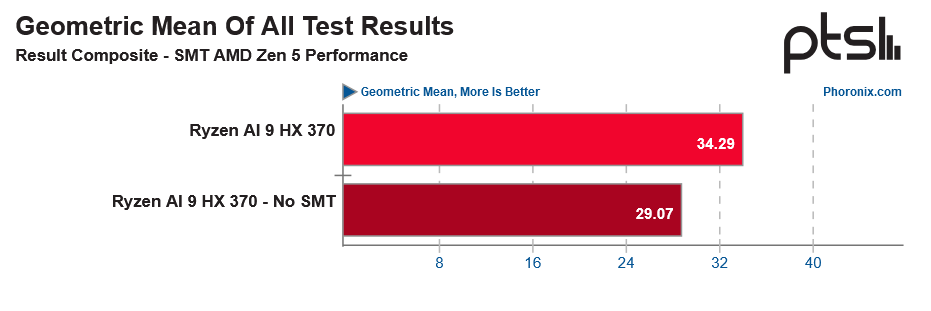
One of the major surprises Intel revealed during its Lunar Lake architecture announcement was the decision to remove Hyper-Threading (SMT) from its next-generation thin and light-optimized architecture. New Zen 5/Zen5C multi-threading benchmarks from Phoronix suggest that this feature still benefits AMD CPUs, showing significant performance and efficiency gains from having two threads on a single core.
Phoronix tested AMD's Ryzen AI 9 HX 370 in Linux with its four Zen 5 cores and eight Zen 5c cores, all featuring simultaneous multithreading (SMT) capabilities. The Linux-focused outlet tested the chip with SMT and turned on and off in various tests in Ubuntu 24.04 to see the advantages (or disadvantages) of AMD's SMT.
All 57 benchmarks showed a performance advantage with SMT enabled. On average, the Ryzen AI 9 HX 370 performed 18% faster when using SMT than running the same benchmarks without SMT. Some benchmarks performed even better than 18% with SMT, showing as much as a 67% performance advantage in the case of the toyBrot Fractal Generator benchmark.
Power consumption was also virtually unaffected when SMT was enabled. Phoronix recorded an average power consumption of 19.27 watts with SMT disabled on the Ryzen AI 9 chip and 19.63 watts with SMT enabled, translating into a measly 2% power impact with SMT enabled. Thermals were also unaffected, with the chip operating at identical temperatures with SMT enabled and disabled.

The Phoronix benchmarks demonstrate that Zen 5 and Zen 5c benefit massively from multi-threading technology. In the case of the Ryzen AI 9 HX 370, AMD is only giving up 2% of its power to extract a very impressive 18% more performance from the chip, significantly improving efficiency.
Ironically, Intel removed Hyper-Threading in Lunar Lake to improve performance efficiency. Its next-gen Lion Cove P-cores for Lunar Lake lack Hyper-Threading, so it relies on its substantially faster next-gen E-cores to pick up the slack. Intel says that removing Hyper-Threading allowed its designers to squeeze a 30% improvement in performance per power per area out of the Lion Cove P-cores.
Another critique Intel made on its Hyper-Threading tech was that it was only used as a last resort in its outgoing hybrid CPU architectures, where the secondary threads on the P-cores were only getting leveraged after the E-cores were fully saturated. It was purportedly another reason Intel ditched Hyper-Threading in Lunar Lake.
Nevertheless, Phoronix's testing confirms that Hyper-Threading/SMT is still highly advantageous, even from a power efficiency perspective. There is an argument to be made that AMD's architecture probably benefits more from multi-threading than Intel's competing architectures do. Still, regardless, AMD's Zen 5 architecture demonstrates that multi-threading is advantageous if you optimize for it.
It will be interesting to see how AMD's Ryzen AI 300 series processors compare to Intel's competing Lunar Lake products in the future. We won't have to wait long for comparisons; Lunar Lake is set to arrive next month.







